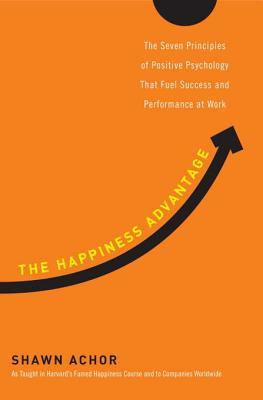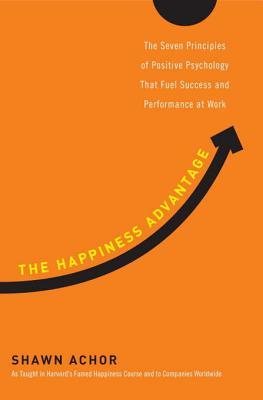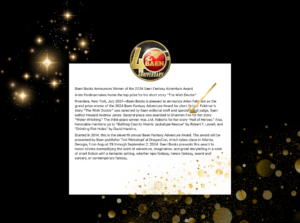Our most commonly held formula for success is broken.
Conventional wisdom holds that if we work hard we will be more successful, and if we are more successful, then we’ll be happy. If we can just find that great job, win that next promotion, lose those five pounds, happiness will follow. But recent discoveries in the field of positive psychology have shown that this formula is actually backward: Happiness fuels success, not the other way around. When we are positive, our brains become more engaged, creative, motivated, energetic, resilient, and productive at work. This isn’t just an empty mantra. This discovery has been repeatedly borne out by rigorous research in psychology and neuroscience, management studies, and the bottom lines of organizations around the globe.
In The Happiness Advantage, Shawn Achor, who spent over a decade living, researching, and lecturing at Harvard University, draws on his own research—including one of the largest studies of happiness and potential at Harvard and others at companies like UBS and KPMG—to fix this broken formula. Using stories and case studies from his work with thousands of Fortune 500 executives in 42 countries, Achor explains how we can reprogram our brains to become more positive in order to gain a competitive edge at work.
Isolating seven practical, actionable principles that have been tried and tested everywhere from classrooms to boardrooms, stretching from Argentina to Zimbabwe, he shows us how we can capitalize on the Happiness Advantage to improve our performance and maximize our potential.

I will never forget the first time anyone thought I had any sort of promise as a student. As an only child, even at five years old, you know your parents love and praise you because that’s what parents do. But that first time anyone outside my family communicated a sense of belief in my promise is forever burned into my brain.
It was Christmas and I was in Kindergarten. Almost the first thing you learn in Kindergarten is the letters of alphabet and how to read and write. I loved all these things from the onset, but it wasn’t until December that I had any idea that perhaps I was showing a great deal of success in this arena. I hardly remember what the assignment was –writing something that had to do with Christmas– but I will always remember my teacher pulling me aside to tell me how excellent my work was and handing me a note to bring home to my parents. A note I enthusiastically read. In it, she praised the complexity and imagination in my work.
For the first few months in Kindergarten, I had watched other children occasionally be pulled aside and tasked with special “advanced” projects. While I would not be tapped for such a group until the 4th grade, this first acknowledgement of my personal success awakened me to the possibility that I could be part of this insiders group, these kids who were working above grade level. It had never occurred to me that I could try to be anything more than what I was. I was who I was and they were who they were – smart.
Over the last six months, I’ve been reading and listening to a lot of ideas about success. I’ve learned a lot about how the brain works and chief among them is the idea that we can become whatever we set our mind to – quite literally. This is a form of cognitive dissonance. When what you believe is at odds with what you experience, the brain tries to resolve that dissonance by bringing internal and external realities into alignment.
The main principle of The Happiness Advantage is this – happiness fuels success. Happy people attract success into their lives. If by some miracle you achieve success without being truly happy, you won’t be any happier having achieved that success.
Achor describes 7 principles to achieve greater happiness and resilience. Many of them I’ve seen at work in my own life, many I strive to practice, and many I need to work on.
The first principle is The Happiness Advantage. In summation, a mindset of positivity helps us perform better and achieve more success. We can choose to be happy. You can also prime other people to be happy in the way that you speak to them.
Going back to my little short story above: my teacher primed me for success. And while I was by no means an overnight sensation, her words that I carry around as an adult over two decades later, set me up to achieve success where it was possible. Without her positive encouragement, I wouldn’t have set my mind to becoming a better reader and writer. I had no idea that I was anything over than average until she said something and primed me to achieve success in these areas.
The second principle is The Fulcrum and The Lever. Change is possible. Nothing is ever fixed or pre-determined when it comes to the brain. How we talk to ourselves and others talk to us, determines our course of action.
In this chapter, Achor writes of an experiment by Robert Rosenthal. In it, he delivers intelligence tests to a classroom of students. He told their teachers which ones had performed the best and had the best potential for success. But the students were not told. At the end of the year, the students were re-tested again and those first “superstar” students tested off-the-charts. Here’s the kicker: those students weren’t any more intelligent than the others. Rosenthal simply picked a few students at random. But what happened here was that the teachers non-verbally communicated their belief in their students and the students responded in kind.
The third principle is The Tetris Effect. This principle deals with the idea that the brain can be trained. You can train your brain to become good at Grand Theft Auto. And you can also train your brain to scan your environment for positivity, rather than negativity.
The fourth principle, Falling Up, could also go by the code phrase we use at my work: “Flip It”. Happy people excel at seeking positive in the negative. Achor gives a powerful example of this in his book.
Imagine that you walk into a bank. There are 50 other people inside. A robber walks in and fires his gun one time. You are hit in the arm.
Now, if you were retelling this event to your friends the next time, do you describe it as a lucky or an unlucky occurrence?
Positive and happy people would say they are lucky. Lucky they weren’t seriously hurt. Lucky no one else was seriously hurt. Lucky that no one died.
Failure is essential to happiness. It’s how you flip it.
The fifth principle is The Zorro Circle. Limit your focus to small, manageable skills to expand your sphere of power. Think of a juggler. At first, he cannot juggle three balls at once. But as soon as he masters three balls, he adds a fourth. When he masters that, he adds a fifth, and so on. No one become an overnight sensation. If where you want to go is far from where you are, focus on taking small, progressive steps. Eventually, you will master what you need to to achieve your goal.
The sixth principle is The 20-Second Rule. We are bundles of habit. To change ourselves and achieve success, we need to exchange bad habits for good ones. But to do this, we need to lower our barriers for change.
Think about why most everyone fails at their New Year’s Resolutions. They’ve set their mind to create good habits without lowering the barriers to get there.
The seventh principle is Social Investment. Happy people have strong, positive connections with other people. The sense of being supported is intrinsic to our achievement of happiness.
One final thought from the book: when you practice these principles of happiness and begin to change, you rub off on other people and begin to change the world around you.
Do yourself a favor and go pick up this book. It’s a fast, easy read with life-changing information.




